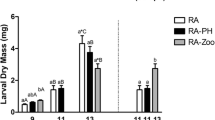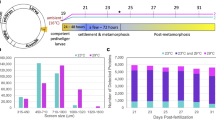Abstract
While physiological changes associated with copper toxicity have been studied in adult fathead minnow, Pimephales promelas, little is known about the effect of copper on newly hatched larvae. As a result we initiated an investigation on the mechanism of copper toxicity in 24 h post-hatch larvae using gene expression changes to identify responsive genes. Fish were exposed to copper concentrations of 0, 50, 125 and 200 μg/L in a 48 h toxicity test. Total RNA from survivors was used in a differential display assay to screen for differentially expressed gene products. Altogether, 654 copper-responsive differentially expressed bands were collected. Database searches found homology for 261 sequences. One hundred and sixty-one bands were homologous to NCBI genes of known function, of which 69 were individual genes. The most abundant categories of functional genes responding to copper were involved in protein synthesis/translational machinery and contractile proteins. Twenty-one dose-responsive genes were measured for expression changes using real-time quantitative PCR. Differential gene expression was validated for 11 of 13 genes, when a 1.2 times qPCR difference between the copper and control samples was observed. Transcripts identified as titin, cytochrome b, fast muscle specific heavy myosin chain 4, fast muscle troponin I, proteasome 26S subunit and troponin T3a were induced over twofold. Differential display bands identified as 60S ribosomal proteins L27 and L12 were repressed approximately threefold. We conclude that copper exposure affects several cellular pathways in larval fathead minnows with protein synthesis, ribosome structure, and muscle contractile proteins being the most sensitive to this stress.




Similar content being viewed by others
References
Altschul SF, Madden TL, Schäffer AA et al (1997) Gapped BLAST and PSI-BLAST: a new generation of protein database search programs. Nucleic Acids Res 25:3389–3402. doi:10.1093/nar/25.17.3389
Aruga J, Yokota N, Mikoshiba K (2003) Human SLITRK family genes: genomic organization and expression profiling in normal brain and brain tumor tissue. Gene 315:87–94. doi:10.1016/S0378-1119(03)00715-7
Baker JTP (1969) Histological and microscopical observations on copper poisoning in the winter flounder (Pseudopleuronectes americanus). J Fish Res Board Can 26:2785–2793
Bartosiewicz M, Penn S, Buckpitt A (2001) Applications of gene arrays in environmental toxicology: fingerprints of gene regulation associated with cadmium chloride, benzo (a) pyrene, and trichloroethylene. Environ Health Perspect 109:71–74. doi:10.2307/3434924
Beretta L, Dubois MF, Sobel A et al (1995) Stathmin is a major substrate for mitogen-activated protein kinase during heat shock and chemical stress in HeLa cells. Eur J Biochem 227:388–395. doi:10.1111/j.1432-1033.1995.tb20401.x
Blaxter JHS (1988) Pattern and variety in development. In: Hoar WS, Randall DJ (eds) Fish physiology, vol XI, Part A. Academic Press, San Diego
Brooks ML, Boese CJ, Meyer JS (2006) Complexation and time-dependent accumulation of copper by larval fathead minnows (Pimephales promelas): implications for modeling toxicity. Aquat Toxicol 78:42–49. doi:10.1016/j.aquatox.2006.02.002
Carpenter KE (1927) The lethal action of soluble metallic salts on fishes. J Exp Biol 4:378–390
Chan KM, Ku LL, Chan C-Y et al (2006) Metallothionein gene expression in zebrafish embryo-larvae and ZFL cell-line exposed to heavy metal ions. Mar Environ Res 62:S83–S87. doi:10.1016/j.marenvres.2006.04.012
Chen WY, John JA, Lin CH et al (2004) Expression of metallothionein gene during embryonic and early larval development in zebrafish. Aquat Toxicol 69:215–227. doi:10.1016/j.aquatox.2004.05.004
Cheung AP, Lam TH, Chan KM (2004) Regulation of Tilapia metallothionein gene expression by heavy metal ions. Mar Environ Res 58:389–394. doi:10.1016/j.marenvres.2004.03.084
David CPC (2003) Establishing the impact of acid mine drainage through metal bioaccumulation and taxa richness of benthic insects in a tropical Asian stream (The Philippines). Environ Toxicol Chem 22:2952–2959. doi:10.1897/02-529
Denslow ND, Bowman CJ, Ferguson RJ et al (2001) Induction of gene expression in sheepshead minnows (Cyprinodon variegatus) treated with 17β-estradiol, diethylstilbestrol, or ethinylestradiol: the use of mRNA fingerprints as an indicator of gene regulation. Gen Comp Endocrinol 121:250–260. doi:10.1006/gcen.2001.7605
Devlin EW, Brammer JD, Puyear RL et al (1996) Prehatching development of the fathead minnow Pimephales promelas Rafinesque. USEPA publication EPA/600/R-96/079, Cincinnati
Donaldson EM, Dye HM (1975) Corticosteroid concentrations in sockeye salmon (Oncorhynchus nerka) exposed to low concentrations of copper. J Fish Res Board Can 32:533–539
Fei G, Guo C, Sun HS et al (2007) Chronic hypoxia stress-induced differential modulation of heat-shock protein 70 and presynaptic proteins. J Neurochem 100:50–61. doi:10.1111/j.1471-4159.2006.04194.x
Galkin O, Bentley AA, Gupta S et al (2007) Roles of the negatively charged N-terminal extension of Saccharomyces cerevisiae ribosomal protein S5 revealed by characterization of a yeast strain containing human ribosomal protein S5. RNA 13:2116–2128. doi:10.1261/rna.688207
Gardner GR, LaRoche G (1973) Copper induced lesions in estuarine teleosts. J Fish Res Board Can 30:363–368
Hannan KM, Brandenburger Y, Jenkins A et al (2003) mTOR-dependent regulation of ribosomal gene transcription requires S6K1 and is mediated by phosphorylation of the carboxy-terminal activation domain of the nucleolar transcription factor UBF. Mol Cell Biol 23:8862–8877. doi:10.1128/MCB.23.23.8862-8877.2003
Hernandez PP, Moreno V, Olivari FA et al (2006) Sub-lethal concentrations of waterborne copper are toxic to lateral line neuromasts in zebrafish (Danio rerio). Hear Res 213:1–10. doi:10.1016/j.heares.2005.10.015
Hilfiker S, Pieribone VA, Nordstedt C et al (1999) Regulation of synaptotagmin I phosphorylation by multiple protein kinases. J Neurochem 73:921–932. doi:10.1046/j.1471-4159.1999.0730921.x
Hua Y, Zhou J (2004) Survival motor neuron protein facilitates assembly of stress granules. FEBS Lett 572:69–74. doi:10.1016/j.febslet.2004.07.010
Infante C, Asensio E, Canavate JP et al (2008) Molecular characterization and expression analysis of five different elongation factor 1 alpha genes in the flatfish Senegalese sole (Solea senegalensis Kaup): differential gene expression and thyroid hormones dependence during metamorphosis. BMC Mol Biol 9:19–36. doi:10.1186/1471-2199-9-19
Karan V, Vitorović S, Tutundžić V et al (1998) Functional enzymes activity and gill histology of carp after copper sulfate exposure and recovery. Ecotoxicol Environ Saf 40:49–55. doi:10.1006/eesa.1998.1641
Kyle HM (1926) The biology of fishes. The Macmillan Company, New York
Landriscina M, Bagalá C, Mandinova A et al (2001) Copper induces the assembly of a multiprotein aggregate implicated in the release of fibroblast growth factor 1 in response to stress. J Biol Chem 276:25549–25557. doi:10.1074/jbc.M102925200
Lange S, Xiang F, Yakovenko A et al (2005) The kinase domain of titin controls muscle gene expression and protein turnover. Science 308:1599–1603. doi:10.1126/science.1110463
Larkin P, Villeneuve DL, Knoebl I et al (2007) Development and validation of a 2,000-gene microarray for the fathead minnow (Pimephales promelas). Environ Toxicol Chem 26:1497–1506. doi:10.1897/06-501R.1
Lewis SS (2005) Identification of stress-responsive genes in the early larval stage of the fathead minnow Pimephales promelas. Ph.D. dissertation. University of Cincinnati, Cincinnati
Liang P, Pardee AB (1992) Differential display of eukaryotic messenger RNA by means of the polymerase chain reaction. Science 257:967–971. doi:10.1126/science.1354393
Linskens MH, Feng J, Andrews WH et al (1995) Cataloging altered gene expression in young and senescent cells using enhanced differential display. Nucleic Acids Res 23:3244–3251. doi:10.1093/nar/23.16.3244
Livak KJ, Schmittgen TD (2001) Analysis of relative gene expression data using real-time quantitative PCR and the 2−∆∆CT method. Methods 25:402–408. doi:10.1006/meth.2001.1262
McKim JM (1977) Evaluation of tests with early life stages of fish for predicting long-term toxicity. J Fish Res Board Can 34:1148–1154
McKim JM, Eaton JG, Holcombe GW (1978) Metal toxicity to embryos and larvae of eight species of freshwater fish-II: copper. Bull Environ Contam Toxicol 19:608–616. doi:10.1007/BF01685847
Moore JW, Ramamoorthy S (1984) Heavy metals in natural waters, applied monitoring and impact assessment. Springer, New York
Mount DI (1968) Chronic toxicity of copper to fathead minnows (Pimephales promelas, Rafinesque). Water Res 2:215–223. doi:10.1016/0043-1354(68)90027-4
Newman MC, Unger MA (2003) Fundamentals of ecotoxicology, 2nd edn. Lewis, Boca Raton
Patel PH, Tamanoi F (2006) Increased Rheb-TOR signaling enhances sensitivity of the whole organism to oxidative stress. J Cell Sci 119:4285–4292. doi:10.1242/jcs.03199
Rubin CI, Atweh GF (2004) The role of stathmin in the regulation of the cell cycle. J Cell Biochem 93:242–250. doi:10.1002/jcb.20187
Sanders BM, Nguyen J, Martin LS et al (1995) Induction and subcellular localization of two major stress proteins in response to copper in the fathead minnow Pimephales promelas. Comp Biochem Physiol C Pharmacol Toxicol Endocrinol 112:335–343
Scudder BC, Carter JL, Leland HV (1988) Effects of copper on development of the fathead minnow, Pimephales promelas Rafinesque. Aquat Toxicol 12:107–124. doi:10.1016/0166-445X(88)90029-X
Shumyatsky GP, Malleret G, Shin RM et al (2005) Stathmin, a gene enriched in the amygdala, controls both learned and innate fear. Cell 123:697–709. doi:10.1016/j.cell.2005.08.038
Sompayrac L, Jane S, Burn TC et al (1995) Overcoming limitations of the mRNA differential display technique. Nucleic Acids Res 23:4738–4739. doi:10.1093/nar/23.22.4738
Stokes PM (1979) Copper accumulations in freshwater biota. In: Nriagu JO (ed) Copper in the environment. Part I. Ecological cycling. Wiley, New York, pp 358–381
Takagi M, Absalon MJ, McLure KG et al (2005) Regulation of p53 translation and induction after DNA damage by ribosomal protein L26 and nucleolin. Cell 123:49–63. doi:10.1016/j.cell.2005.07.034
Tan FL, Moravec CS, Li J et al (2002) The gene expression fingerprint of human heart failure. Proc Natl Acad Sci USA 99:11387–11392. doi:10.1073/pnas.162370099
Taylor EW, Beaumont MW, Butler PJ (1996) Lethal and sub-lethal effects of copper upon fish: a role for ammonia toxicity? In: Taylor EW et al (eds) Toxicology of aquatic pollution: physiological, cellular and molecular approaches. Cambridge University Press, New York, pp 85–114
Thome J, Pesold B, Baader M et al (2001) Stress differentially regulated synaptophysin and synaptotagmin expression in hippocampus. Biol Psychiatry 50:809–812. doi:10.1016/S0006-3223(01)01229-X
Ton C, Stamatiou D, Dzau VJ et al (2002) Construction of a zebrafish cDNA microarray: gene expression profiling of the zebrafish during development. Biochem Biophys Res Commun 296:1134–1142. doi:10.1016/S0006-291X(02)02010-7
Ton C, Stamatiou D, Liew CC (2003) Gene expression profile of zebrafish exposed to hypoxia during development. Physiol Genomics 13:97–106
Valko M, Morris H, Cronin MTD (2005) Metals, toxicity and oxidative stress. Curr Med Chem 12:1161–1208. doi:10.2174/0929867053764635
Weber CI (1993) Methods for measuring the acute toxicity of effluents and receiving waters to freshwater and marine organisms, 4th edn. EPA/600/4–90/027F, Cincinnati
Wintz H, Yoo LJ, Loguinov A et al (2006) Gene expression profiles in fathead minnow exposed to 2,4-DNT: correlation with toxicity in mammals. Toxicol Sci 94:71–82. doi:10.1093/toxsci/kfl080
Wright P, Felskie A, Anderson P (1995) Induction of ornithine-urea cycle enzymes and nitrogen metabolism and excretion in rainbow trout (Oncorhynchus mykiss) during early life stages. J Exp Biol 198:127–135
Zhang F, Hamanaka RB, Bobrovnikova-Marjon E et al (2006) Ribosomal stress couples the unfolded protein response to p53-dependent cell cycle arrest. J Biol Chem 281:30036–30045. doi:10.1074/jbc.M604674200
Acknowledgments
We acknowledge the contributions of J. Lazorchak, M. Smith, D. Lattier, M. Bagley, C. Tomlinson, R. Flick, D. Gordon, S. Jackson, M. Brown-Augustine, R. Haugland, J. Deddens, S. Keely and J. Stringer to this project. Funds for this project have been provided by the University of Cincinnati Research Foundation through the generosity of the Schlemm Family.
Author information
Authors and Affiliations
Corresponding author
Rights and permissions
About this article
Cite this article
Lewis, S.S., Keller, S.J. Identification of copper-responsive genes in an early life stage of the fathead minnow Pimephales promelas . Ecotoxicology 18, 281–292 (2009). https://doi.org/10.1007/s10646-008-0280-3
Accepted:
Published:
Issue Date:
DOI: https://doi.org/10.1007/s10646-008-0280-3




